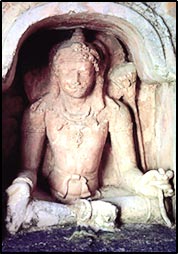Nalanda, Bihar, India (Overview, site map)
Nalanda was a famous Buddhist monastery and university. The region's traditional history dates to the time of the Buddha and Mahavira (6th-5th cent. BCE). Nagarjuna, it is said, studied there. Excavations by the Archaeological Survey of India (ASI) reveal that the monasteries belong to the Gupta period (5th cent. CE), now considered the beginning of Nalanda University, where subjects like theology, grammar, logic, philosophy, metaphysics, astronomy, and medicine were taught. The Gupta kings were a major patron of Nalanda, as was Harshavardhana, the powerful 7th-century ruler of Kannauj. During his reign, the Chinese pilgrim Hiuen Tsang visited Nalanda and left a vivid account of the curriculum and of the general features of the community. I-ching, another pilgrim a generation later, also left an account of the life of the monks.
Between 8th-12th cent., Nalanda flourished under the Pala dynasty as a centre of learning and the arts (stone and bronze sculpture in particular), even as Buddhism began a broad decline in India. Nalanda was put to a brutal and decisive end by Bakhtiyar Khilji, a Turkish invader (c. 1200), who is said to have looted and burned the monastery and killed its senior monks. Local legend has it that the three libraries of Nalanda were so large that they burned for six months.
10,000 monks and 1,500 teachers once inhabited Nalanda in 108 monasteries, which often had two or more floors. Excavations have revealed a row of ten monasteries of oblong red bricks; each has rooms (single or double occupancy, with wooden doors back then) lining four sides of a courtyard, a main entrance on one side, and a shrine facing the entrance in the courtyard. A row of larger shrines, or stupas, in brick and plaster, stand in front of the monasteries. Teachers lived among the students in each monastery, other common features of which include a podium for lectures, a communal brick oven, a bathroom, a water well (often with octagonal cross-section, supposedly inspired by the Eightfold Path).
The local ASI museum houses many of the finds from Nalanda and the surrounding region. A notable theme in sculpture includes Buddhist deities trampling on Brahmanical ones: on Shiva and Parvati, on Ganesh. A Buddhist goddess has mighty Brahmanical gods like Indra, Vishnu, and Shiva as her "vehicle bearers", while she carries the severed head of Brahma in one hand. Buddhism in India, by the end of the first millennium, was losing out to Bhakti, or devotional Hinduism, and this probably put the Buddhists on the defensive. They had lost most of their royal patronage. They had to resort to more dramatic imagery to assert their religious superiority to the ambivalent.
 The ruins of the ancient residential university of Nalanda near Patna, in Bihar, are the silent reminders of the high levels attained in the field of education and learning in India during the ancient ages. Nalanda was one of the best known universities of its time, attracting thousands of students from far off places. Scholars all over Asia and other countries in the Middle East had learnt about Nalanda and continued to visit Nalanda till its destruction by the Turkish and Afghan invaders in the 12th century. The place is now one of the tourist attractions in Bihar and attracts tourists, especially Buddhists from all over the world. Touristplacesinindia.com provides online information about Nalanda and other famous as well as lesser known tourist spots in India.
The ruins of the ancient residential university of Nalanda near Patna, in Bihar, are the silent reminders of the high levels attained in the field of education and learning in India during the ancient ages. Nalanda was one of the best known universities of its time, attracting thousands of students from far off places. Scholars all over Asia and other countries in the Middle East had learnt about Nalanda and continued to visit Nalanda till its destruction by the Turkish and Afghan invaders in the 12th century. The place is now one of the tourist attractions in Bihar and attracts tourists, especially Buddhists from all over the world. Touristplacesinindia.com provides online information about Nalanda and other famous as well as lesser known tourist spots in India.